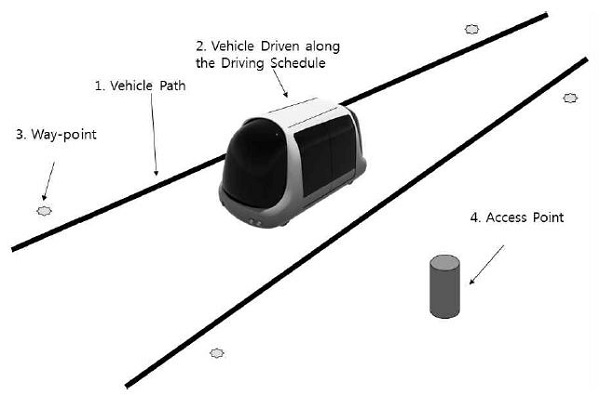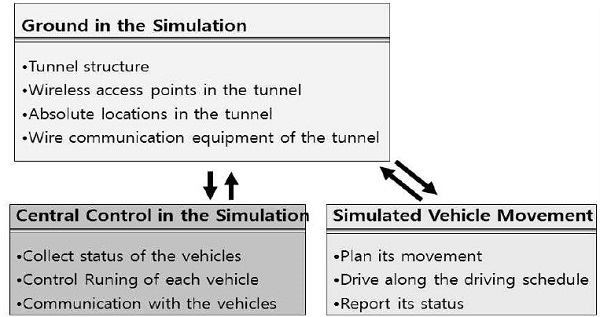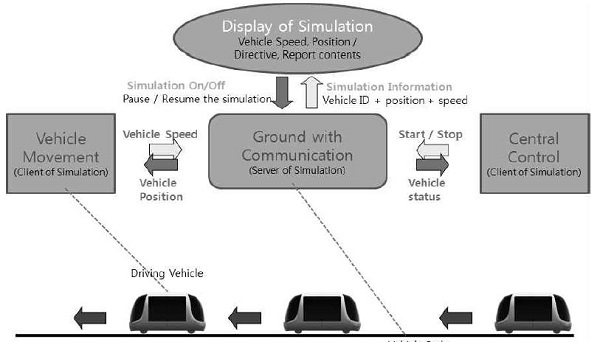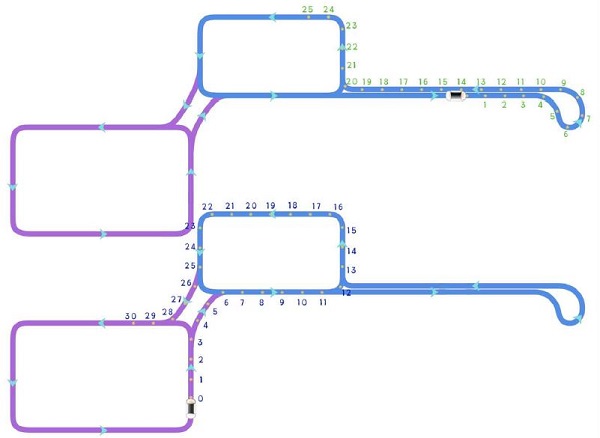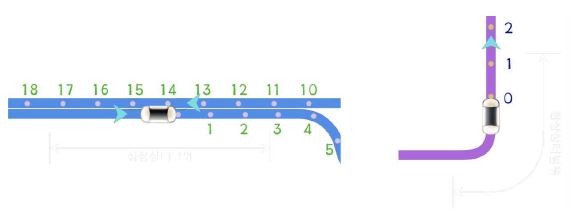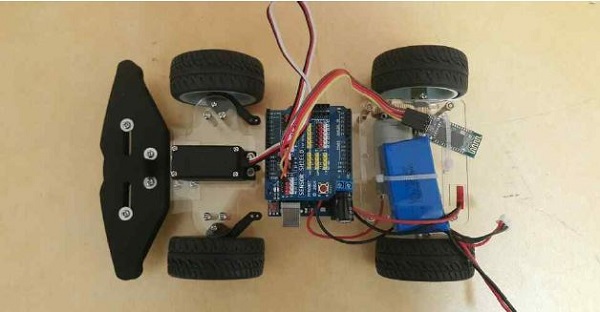
A Simulation-Experiment of Vehicle Conforming to a Driving Schedule on Tunnel-way with Cyber-Physical Vehicle Environment
Abstract
Electric vehicles could drive on the tunnel-way constructed in the form of concatenated tunnels in the similar direction, in near future. A predetermined route is traveled on the unaltered route basis within a bounded travel time. For directing vehicles driving in the tunnels, vehicle travel times are crucial to determine travel routes. For fluent and safe vehicle flow in the tunnel-way, the actual automatic driving should be exact to the scheduled route. In the driving experiment we adopted a control technique on which vehicle is presupposed as Cyber-Physical System, CPS, for the purpose of automatic driving control. The experiment is conducted along with the simulation. This simulation incorporating the experiment might be an evaluation tool for the central control of vehicles running on the tunnel-way. Despite the vehicle model is different and an exact contrasting is difficult, the lower error rate is achieved in the simulation of this work.
초록
가까운 미래, 전기자동차는 터널 연결로 구성된 터널길을 운행할 수 있을 것이다. 제한된 이동시간 내에 경로가 변경되지 않는 기준의 미리 결정된 경로를 이동한다. 터널들에서 주행하는 차량들을 통제하는데는 차량 이동 시간이 경로를 결정하는데 중요하다. 예정된 경로를 정확하게 따르는 실제적인 자동주행이 원활하고 안전한 터널길 주행을 위해 이루어져야 한다. 차량의 자동주행 제어를 CPS 모델링으로 구성한 제어기법을 채택하여 주행 실험을 수행하였고, 시뮬레이션이 함께 수행되었다. 실험이 병행된 이 시뮬레이션은 터널길에서 주행하는 차량들의 중앙통제 방안을 평가하는 툴이 될 것이다. 대상 차량모델의 차이로 적확한 비교를 하기는 어려우나, 이전 연구에 비해 낮은 오차를 가지는 시뮬레이션이 이루어졌다.
Keywords:
tunnel-way, automatic driving, cyber-physical vehicle system, driving schedule, definite travel-time basisⅠ. Introduction
Electric vehicles are the potential future vehicle, and they are conjectured to drive underneath the ground often in future. Due to its nature of no emission from the vehicle, driving in tunnels does not incur pollution problem in the tunnel. This work has a particular contribution under the premise of a promising future car-driving environment that many of cars are driving beneath the ground in urban regions[1]. The predetermined route of the driving vehicle is traveled on the unaltered route basis within a bounded travel time. The route calculation function of the directing server designates the predetermined travel route for each driving vehicle considering the merge of two routes. The vehicle is driven by drive commands of a driving schedule within a predefined time variance along the scheduled route. The current speed, position, and steering angle are reported in the driving, and this information is displayed on the directing server. There is a route / situation screen that can alter to abort the schedule against an abnormal situation in the current driving. The driving experiment performed in this work is a miniature-sized implementation of the drive controller of a tiny vehicle.
Since the actual automatic driving should be exact to the scheduled route, we adopted a control technique proposed in [2] on which vehicle is presupposed as Cyber-Physical System, CPS, for the purpose of automatic driving control. In the tiny vehicle experiment the exactness is met with requirements for the case of basic running tests.
For directing vehicles driving in the tunnels, vehicle travel times are crucial to determine travel routes. In this work the differentiation of the travel time of vehicle is investigated with its changed weight through the experiment along with simulation, by driving a tiny vehicle in real world and then in the cyber space. Changed weights are placed in the experiment only.
Ⅱ. Background
For Cyber-Physical Vehicle Systems, CPVS, in the most general sense, control or regulation makes use of algorithms and feedback to calculate inputs for cyber and physical effectors that provide services, translocate or reorient the vehicle, ensure safety and achieve objectives. Holistic, integrated, tightly-coupled CPS modeling and control of both cyber and physical effectors are referred to as co-regulation[2]. Most of this section is referred to a survey of optimization and control of CPVS[2].
2.1 Feedback Scheduling
Feedback, as a principle, offers robustness to off-nominal conditions by using past measurements to compute future inputs to the system and has been applied in many domains. Most related to control of CPVS, and a departure from control of the physical system, is feedback scheduling. Feedback scheduling adjusts cyber resources based on the needs of the cyber system[3]. It accomplishes this by adapting traditional control theory to regulate the task schedule in the RTS. This, in turn, contributes to regulating the CPS as a whole. In this scheme, sampling periods of various control tasks are adjusted, and subtasks (parts of a task) are scheduled using feedback from execution time measurements and feedforward from workload changes[4].
Feedback scheduling algorithms can be computationally intense. A simple (i.e., linear) model that relates the cost of control performance to cyber resources would provide an excellent tool for feedback scheduling, which can then less expensively design task schedules[5].
2.2 Time-Varying Sampling
Uncertainty in sampling rate can be caused by transmission delays in a NCS, jitter and/or missed deadlines in the RTS, etc. Research investigating the design of controllers under uncertain delays has resulted in more robust systems. Typically, as in NCS research, these approaches consider a small range of possible sampling rates and stability, and robustness guarantees are given for that range under time-varying control schemes[6]. Successful optimal controllers under these circumstances using a linear matrix inequality (LMI) approach have been designed[7][8].
2.3 Coupled Cyber-Physical Co-regulation
Assuming a physical system modeled as:
| (1) |
where is the physical state vector, Ap the system matrix, Bp the control matrix and up the physical control input, we seek a system of the form:
| (2) |
where components with subscript c are the cyber system analogs to the physical model components.
This allows us to write the coupled CPS as:
| (3) |
This co-regulation scheme has illustrated CPS tradeoffs possible over a series of domains including a spring-mass-damper system [9] and inverted pendulum [10], as well as the CubeSat domain[11].
In all cases, co-regulation consistently demonstrated good physical system tracking performance, while significantly reducing computational load. This abstraction approach to CPS co-regulation allows an engineer to leverage the wealth of traditional statespace control design techniques and to treat the scheduling of tasks as a control problem wherein interactions between cyber and physical states are represented in a common framework. It also provides the benefits of time-triggered control, such as ease of RTS scheduling and hard timing guarantees, while also offering the benefits of "on-demand" event-triggered control to reduce cyber resource utilization.
Ⅲ. Constitution of the Simulation
3.1 Directing and driving of a vehicle in cyber environment
The tunnel-way is constructed in the form of concatenated tunnels in the similar direction. The first entity is the tunnel-way in the simulation, with markers indicating absolute locations determinatively displaced from one another. Tunnel entity embeds wireless communication capability for the vehicles. The second entity is a central control that directs the vehicles driving through the tunnel. Central control entity receives the states of all the driving vehicles and sends the respective scheduled route to each vehicle. The last entity is each vehicle driving with its scheduled route. Vehicle entity automatically drives along the scheduled route and periodically communicates with Central control for its status update in the central control.
Central control is established for traffic control in the tunnel-way and placed at the Ground as shown in Fig. 2. As Ground is the base of vehicle driving, the movement of each vehicle is substantiated in Ground, and the result is returned to Vehicle with its Movement method. The Vehicle sends its status including its position in the tunnel through Ground Communication method to Central control periodically. The traffic situation is displayed via Ground as shown in Fig. 3.
The functionalities of the entities are enlisted in Table I.
3.2 Directing and driving of a vehicle in physical environment
Opposed to the vehicle in cyber environment, a tiny vehicle would run the vehicle path in physical environment. A tiny vehicle off-the-shelf has been employed for an running experiment. Its driving performance is examined on a flat land and the performance factors are applied to the vehicle in the cyber environment. The vehicle of either environment shares the features summarized in Table 1.
Directing Server corresponds to Central Control of cyber environment, and Drive Controller corresponds to Vehicle Movement method of cyber environment. Two other feature of functions are the same in the cyber environment. In either environment, additional conceptual features governs the running of the vehicle. One is definite travel time. It is acquisited by averaging the tiny vehicle’s driving in the flat land. The scheduled route is composed of definite travel times. The other is vehicle driving in hard real time. It should be accomplished in the running experiment by velocity adjustment to keep up with the scheduled route. Fig. 4 is the tunnel structure in this work, with two drive routes for two driving vehicles, respectively.
The drive controller that controls the vehicle is placed in the tiny vehicle, and receives instructions from, and sends reports to the directing server. As shown in Table 1, the two computers are connected to each other through a wireless network. In the case of instructing the directing server sends the instruction, and receives the report in the case of reporting. The drive controller sends a driving command to the tiny vehicle through wire communication, and the tiny vehicle returns the result on that driving. Since there could be dozens of driving vehicles, the drive controller periodically reports the driving state so that the directing server manages the driving states of all the vehicles travelling. The drive controller executes the driving command sequences according to the driving schedule within the time variance admitted, by steering and forwarding with speed control of the driving vehicle. The directing server confirms whether each driving vehicle conforms to its driving schedule. The driving schedule in Fig. 5 is created by calculating the travel time of the route between the driving vehicles on the definite travel-time basis.
3.3 Drive control of a vehicle in both environment
On the drive routes of Fig. 4, 6 positions are common in the drive routes of the 2 vehicles. Under two suppositions that it takes the uniform time from one position to another and that 2 vehicles have started at the same time, the 2 vehicles would not collide with. Both suppositions are not realistic, and further the first supposition is out of physical laws. For these vehicles run on their drive routes in safe manner, their movements should be deterministic. The deterministic movements are equal to the combination of sequenced commands that control the driving vehicle, including straight-forward, stopping, accelerating, and turning in physical environment.
The deterministic movements could be realized with decomposing a route in a speed alteration procedure. The roue is decomposed into speeding-up sections, speeding-down sections, and uniform-speed sections. The decomposed route is a series of deterministic movements and named Driving Schedule as depicted in Fig. 6.
In every section the vehicle drives in the process of complying a Target Velocity, the speed level that vehicle should normally attain to. With a target velocity in each section the vehicle movement ought to be deterministic.
These commands set values for driving of the vehicle.
Initialization
Speed command1 : Target velocity 2
Speed command2 : Target velocity 4
Speed command3 : Target velocity 2
Speed command4 : Target velocity 2
Stop command
These commands set values for driving of the vehicle.
Initialization
Speed command1 : Target velocity 4
Speed command2 : Target velocity 4
Speed command3 : Target velocity 4
Speed command4 : Target velocity 2
Speed command5 : Target velocity 2
Speed command6 : Target velocity 4
Speed command7 : Target velocity 2
Speed command8 : Target velocity 4
Stop command
Ⅳ. Experimentation along with Simulation
Cyber-physical vehicle system in this work is realized by superimposing vehicles of real world on the vehicle of the cyber space. A tiny vehicle runs the drive routes with respective drive schedules, and driving times of either section is defined with an average of multiple driving times in the section. The defined driving time is presumed to be the standard driving time of either section in the cyber space. Subsequently the formula of speed alteration is captured from the data recorded during every section in real word. This standard driving times of either section comprises the definite travel time in the simulation. A vehicle could drive along the drive route with driving schedule on the definite travel-time basis in the cyber space.
Afterwards in the experiment, vehicles of a different feature, for instance a lighter vehicle and a heavier vehicle of the same other features drive either sections of the drive routes. A lighter tiny vehicle runs the drive routes and a heavier tiny vehicle runs the drive routes in real world multiple times. As surmised, the heavier vehicle took a longer time to attain to the target velocity of either section, and the lighter vehicle took a shorter time to attain to the target velocity of either section. The averaged speed alterations are shown in Fig. 8 and Fig. 9. Physical1 is the lighter tiny vehicle and Physical2 in the heavier tiny vehicle in real world, experiment. Cyber is the vehicle in the cyber space, the simulation.
Speed alterations of three vehicles in the simulation and the experiment are shown together in Fig. 8 of drive route A that comprises 4 sections. In either section the target velocity changes as described in Section 3.3. With smaller speed difference to next target velocity, the acceleration is also lower and the speed alteration takes longer time than one expected. Speed alterations of three vehicles in the simulation and the experiment are shown together in Fig. 9 of drive route B that comprises 8 sections. In either section the target velocity changes as described in Section 3.3. With larger speed difference to next target velocity, the acceleration is also higher and the speed alteration takes shorter time than one expected. The lap times of either section is determined by attained velocity toward the target velocity of the section. In drive route A of Table 2, a long section of low target velocity takes longer average times than those of the other sections. In drive route B of Table 3, a long section of low target velocity takes longer average times than those of the other sections. Section B2 and B8 have similar numbers of waypoints and the same target velocities, for example, section B2 takes shorter average time than B8 since the target velocity of B7 is lower than that of B8.
With two drive routes we could confirm that two vehicles would drive on the tunnel-way without any interference, when two driving vehicles would start at the same time. The encounter point is at the beginning of Section A4 and at the beginning of Section B5, which are the first common point of two drive routes. In the case both vehicles are of cyber space, one vehicle driving along Route A passes the encounter point at the time 216 (144+54+18) and the other vehicle driving along Route B passes the encounter point at the time 62 (8+20+16+18). In the case Physical1 drives along Route A and Physical2 drives along Route B, the passage times at the encounter point are 200 (128+48+24) and 57 (9+ 20+16+12), respectively. In the case Physical2 drives along Route A and Physical1 drives along Route B, the passage times at the encounter point are 232 (160+60+12) and 66 (6+20+16+24), respectively. Thus the two vehicles could drive in safe on the tunnel-way with the time span ranging between 143 and 166.
Further concerns on this evaluation method could be referred to our previous work of the similar theme[12].
Ⅴ. Conclusion
If the cars driving on the tunnel-way in the future, they should run with intervals for safe driving. For a tiny vehicle as a vehicle model driving on a tunnel-way, the experiment is conducted along with the simulation. A control technique of the design of a cyber-physical vehicle system is adopted and examined in the basic running tests. The drive controller loads the scheduled route and sends a driving command sequence to the tiny vehicle in accordance with the driving schedule. The returned result is logged at the drive controller and then transmitted to the directing server. This simulation incorporating the experiment might be an evaluation tool for the central control of vehicles running on the tunnel-way.
The definite travel-time basis benefits from the control technique of the design of a cyber-physical vehicle system, and it is a prominent foundation for driving on the tunnel-way within the predefined time variance.
Acknowledgments
This research was supported by a grant from R&D Program of the Korea Railroad Research Institute, Republic of Korea
References
- The Boring Company homepage, FAQ, https://www.boringcompany.com/ [Accessed: Sept. 21, 2017].
-
J. M. Bradley, and E. M. Atkins, "Optimization and Control of Cyber-Physical Vehicle Systems", Sensors, 15(9), p23020-23049, Sep), (2015.
[https://doi.org/10.3390/s150923020]

-
L. Sha, T. Abdelzaher, Karl-Erik Årzén, A. Cervin, T. Baker, A. Burns, G. Buttazzo, M. Caccamo, J. Lehoczky, and Aloysius K. Mok, "Real-time Scheduling Theory: A Historical Perspective", Real-time Syst., 28(2-3), p101-155, Nov.-Dec), (2004.
[https://doi.org/10.1023/b:time.0000045315.61234.1e]

- A. Cervin, "Integrated Control and Real-Time Scheduling", Ph.D. dissertation, Lund Univ., Lund, Sweden, (2003).
- J. Eker, P. Hagander, and K. Årzén, "A Feedback Scheduler for Real-Time Control Tasks", Control Eng. Pract., 8(12), p1369-1378, Dec), (2000.
-
E. Fridman, A. Seuret, and J. P. Richard, "Robust sampled-data stabilization of linear systems: An input delay approach", Automatica, 40(8), p1441-1446, Aug), (2004.
[https://doi.org/10.1016/j.automatica.2004.03.003]

-
A. Sala, "Computer control under time-varying sampling period: An LMI gridding approach", Automatica, 41(12), p2077-2082, Dec), (2005.
[https://doi.org/10.1016/j.automatica.2005.05.017]

-
M. Schinkel, W. H. Chen, and A. Rantzer, "Optimal control for systems with varying sampling rate", in Proc. 2002 American Control Conf., p2979-2984, May), (2002.
[https://doi.org/10.1109/acc.2002.1025245]

-
J. M. Bradley, and E. M. Atkins, "Computational- Physical State Co-Regulation in Cyber-Physical Systems", presented at the ACM/IEEE Conference on Cyber-Physical Systems, Chicago, IL, p119-128, Apr), (2011.
[https://doi.org/10.1109/iccps.2011.27]

-
J. M. Bradley, and E. M. Atkins, "Toward Continuous State-Space Regulation of Coupled Cyber-Physical Systems", IEEE Proc, 100(1), p60-74, Jan), (2012.
[https://doi.org/10.1109/jproc.2011.2161239]

-
J. M. Bradley, and E. M. Atkins, "Coupled Cyber-Physical System Modeling and Coregulation of a CubeSat", IEEE Trans. Robot, 31(2), p443-456, Apr), (2015.
[https://doi.org/10.1109/tro.2015.2409431]

-
M. H. Ok, "A Central Navigation of the Autonomous Vehicles in Zone-based Tessellations with Target Velocities", Journal of KIIT, 14(11), p125-132, Dec), (2016.
[https://doi.org/10.14801/jkiit.2016.14.12.125]


1999 : MS degree in Department of Computer Science, Pusan National University.
2009 : PhD ABD in Department of Computer Science, Korea University.
2004 ~ present : Senior Researcher in Korea Railroad Research Institute.
Research interests : autonomous driving, smart car, telematics

